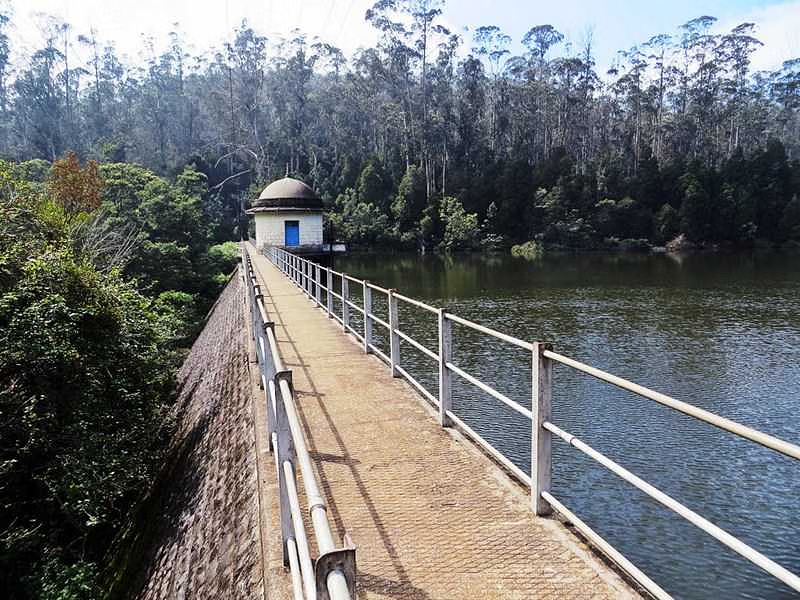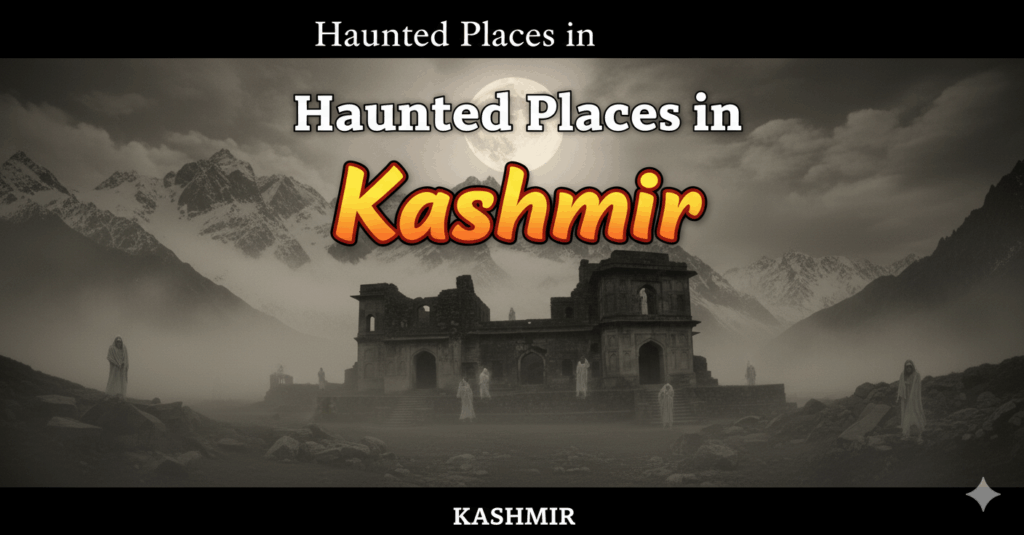Located at an astounding elevation in the Mustang region of Nepal, Muktinath Temple stands as one of the most sacred pilgrimage sites for both Hindus and Buddhists. Understanding the best time to visit Muktinath is crucial due to its extreme altitude, harsh weather conditions, and seasonal accessibility challenges that can make or break your spiritual journey. Poor timing can result in flight cancellations, road closures, altitude sickness, and dangerously cold temperatures that prevent meaningful temple experiences.
The temple’s significance as a liberation shrine attracts thousands of pilgrims annually, but its muktinath height in feet at 12,300 feet above sea level creates unique logistical and health considerations. Weather patterns, accessibility routes, and muktinath temple temperature fluctuations require careful planning to ensure safe passage and comfortable darshan. Strategic timing becomes essential for experiencing this sacred site’s spiritual power while managing the practical challenges of high-altitude pilgrimage.
Table of Contents
Quick Reference Guide: Optimal Times for Muktinath Visit
| Category | Optimal Choice | Temperature Range | Accessibility | Best For |
|---|---|---|---|---|
| Best Season | Spring (Mar-May) | 5°C to 20°C | Excellent roads | First-time pilgrims |
| Best Month | April | 8°C to 18°C | Peak accessibility | Balanced experience |
| Weather Priority | October-November | 0°C to 15°C | Good conditions | Clear mountain views |
| Avoid Period | Dec-Feb (Winter) | -15°C to 5°C | Limited access | Extreme cold |
| Flight Weather | Mar-Nov | Variable | Regular flights | Air travelers |
Understanding these patterns helps you navigate Muktinath’s challenging environment while maximizing both spiritual fulfillment and safety during your high-altitude pilgrimage.
Best Seasons to Visit Muktinath Temple
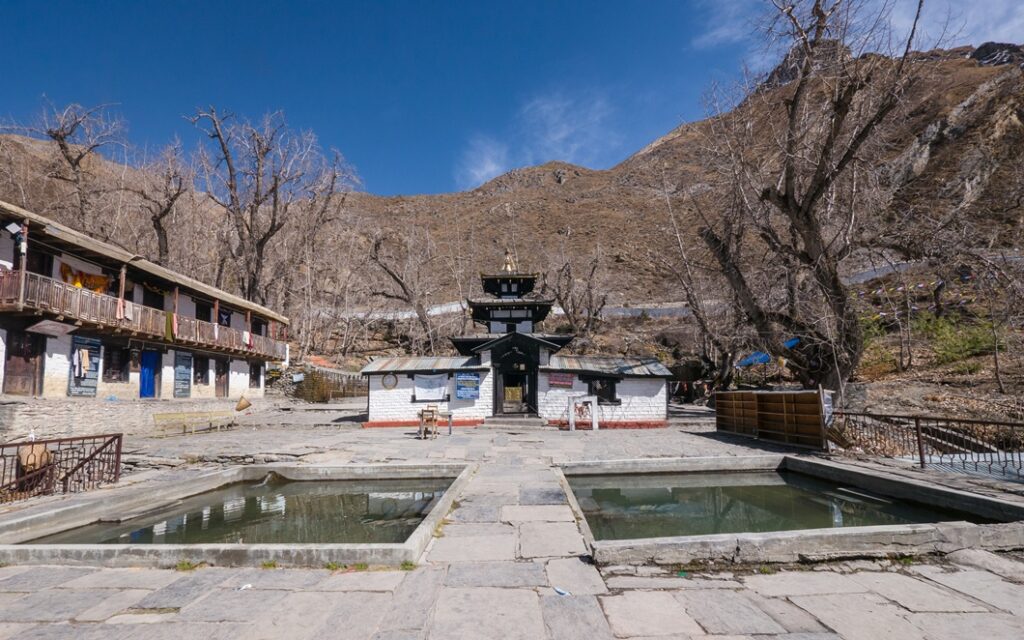
Seasonal timing dramatically affects every aspect of your Muktinath experience, from basic accessibility to spiritual comfort and safety considerations. The temple’s extreme altitude creates weather patterns that differ significantly from lower elevation destinations, requiring specialized knowledge for successful pilgrimage planning. Each season presents distinct advantages and serious challenges that can determine whether your journey becomes a transformative experience or a dangerous ordeal.
Spring (March-May): Optimal Pilgrimage Window
Spring represents the best time to visit Muktinath for most pilgrims seeking reliable access and manageable weather conditions.
March:
- Temperature: 2°C to 15°C (gradual warming trend)
- Accessibility: Roads clearing from winter blockages
- Flight Schedule: Regular Jomsom flights resume
- Pros: Increasing daylight hours, stable weather patterns
- Cons: Occasional late winter storms, limited accommodation heating
- Ideal for: Experienced trekkers, cold-weather tolerant pilgrims
April:
- Temperature: 8°C to 18°C (most comfortable period)
- Accessibility: Peak season for road and air travel
- Flight Schedule: Maximum flight frequency to Jomsom airport
- Pros: Perfect balance of weather and accessibility
- Cons: Higher accommodation costs, advance booking essential
- Ideal for: First-time visitors, elderly pilgrims, family groups
May:
- Temperature: 10°C to 22°C (warmest period)
- Accessibility: Excellent road conditions throughout
- Flight Schedule: Consistent daily flights, minimal cancellations
- Pros: Comfortable temple visits, extended exploration time
- Cons: Pre-monsoon winds, increasing tourist crowds
- Ideal for: Photography enthusiasts, extended stays, cultural exploration
Autumn (September-November): Clear Weather Excellence
Autumn provides crystal-clear mountain views and stable weather, making it the second-best best time to visit Muktinath.
September:
- Temperature: 8°C to 18°C (post-monsoon freshness)
- Accessibility: Roads repaired after monsoon damage
- Flight Schedule: Flights resume after monsoon suspension
- Pros: Clear air, excellent visibility, comfortable temperatures
- Cons: Possible late monsoon effects, road repair delays
- Ideal for: Mountain view seekers, photographers, spiritual retreats
October-November:
- Temperature: 0°C to 15°C (decreasing towards winter)
- Accessibility: Good conditions before winter closure
- Flight Schedule: Regular flights with clear weather advantage
- Pros: Spectacular Himalayan panoramas, crisp clear days
- Cons: Rapidly dropping temperatures, early winter preparation needed
- Ideal for: Experienced high-altitude travelers, short focused visits
Summer/Monsoon (June-August): Challenging Conditions
Monsoon season presents significant accessibility and safety challenges despite moderate temperatures.
June-August:
- Temperature: 12°C to 20°C (warmest overall period)
- Accessibility: Frequently blocked by landslides and floods
- Flight Schedule: Irregular with frequent cancellations
- Pros: Warmest temperatures, lush valley landscapes
- Cons: Road blockages, flight disruptions, landslide risks
- Suitable for: Only experienced adventurers with flexible schedules
Winter (December-February): Extreme Conditions
Winter represents the most challenging muktinath temple temperature conditions with serious accessibility limitations.
December-February:
- Temperature: -15°C to 5°C (severe cold)
- Accessibility: Roads often impassable, limited transport
- Flight Schedule: Frequent cancellations due to weather
- Pros: Peaceful temple atmosphere, fewer crowds
- Cons: Extreme cold, altitude sickness risks, limited facilities
- Recommended only for: Extremely experienced high-altitude pilgrims
Muktinath Temple History and Significance
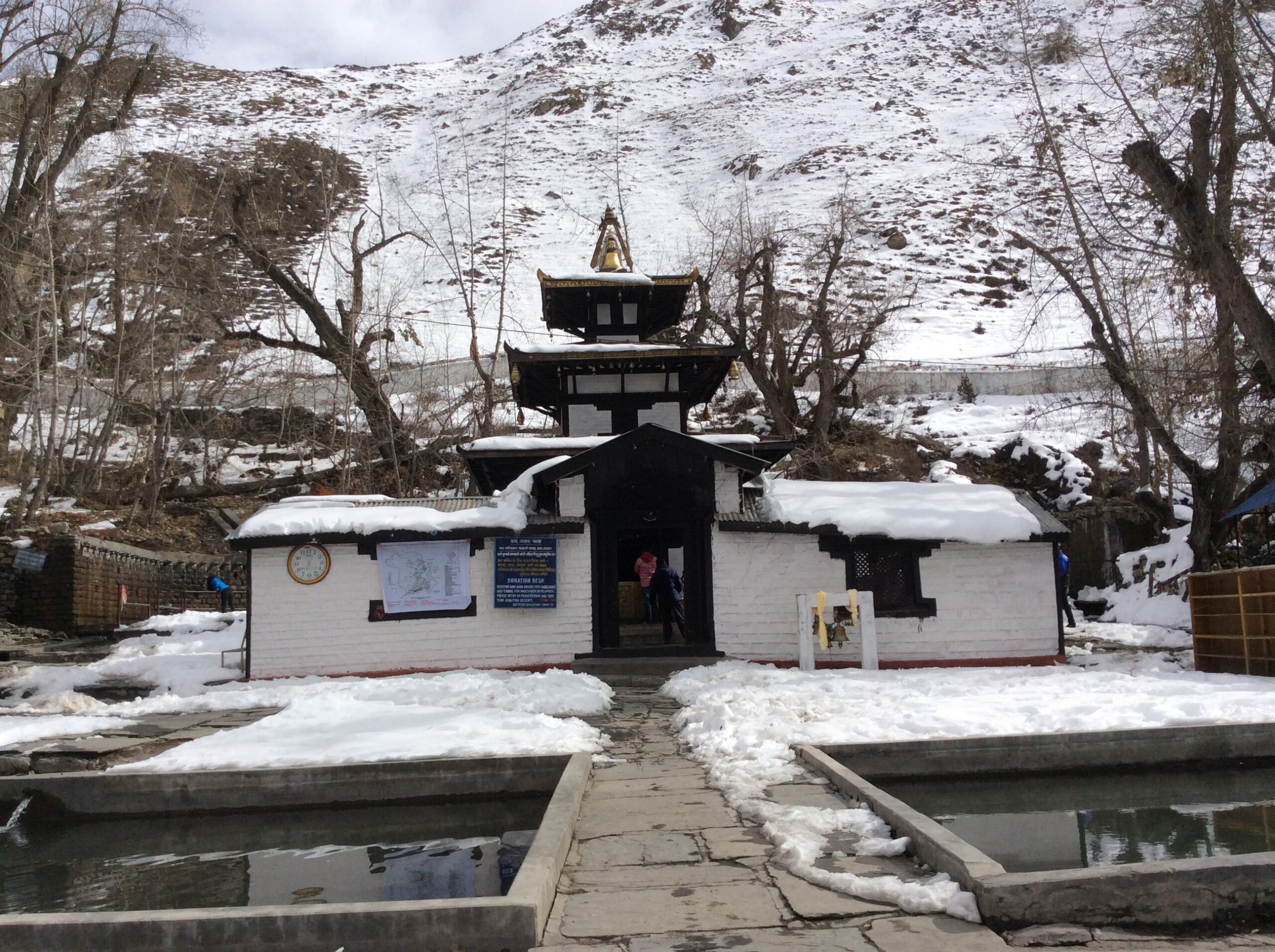
Understanding muktinath temple history enhances appreciation for optimal visiting timing and cultural preparation. This ancient temple, known as “Mukti Kshetra” (place of liberation), holds unique significance as one of the rare shrines sacred to both Hindu and Buddhist traditions. The temple’s 108 water spouts (representing the 108 names of Vishnu) and eternal flames have attracted pilgrims for over 2,000 years, making it one of Nepal’s most revered spiritual destinations. Historical records trace the temple’s importance back to ancient trade routes between India and Tibet, establishing its role as a crucial pilgrimage stop for centuries.
Religious and Cultural Importance
The temple’s dual religious significance creates unique pilgrimage patterns throughout the year:
Hindu Significance:
- Sacred to Lord Vishnu as one of 108 Divya Desams
- Shaligram stones found in nearby Kali Gandaki River
- Liberation site for achieving moksha (spiritual liberation)
- Important stop in Char Dham Yatra circuit
Buddhist Significance:
- Sacred site for Tibetan Buddhist pilgrims
- Connection to Guru Rinpoche’s spiritual journey
- Important meditation and retreat location
- Cultural bridge between Nepal and Tibet
For comprehensive information about the temple’s cultural significance and current pilgrimage guidelines, visit the official Nepal Tourism Board page at https://ntb.gov.np/muktinath–mustang.
How to Reach Muktinath Nepal
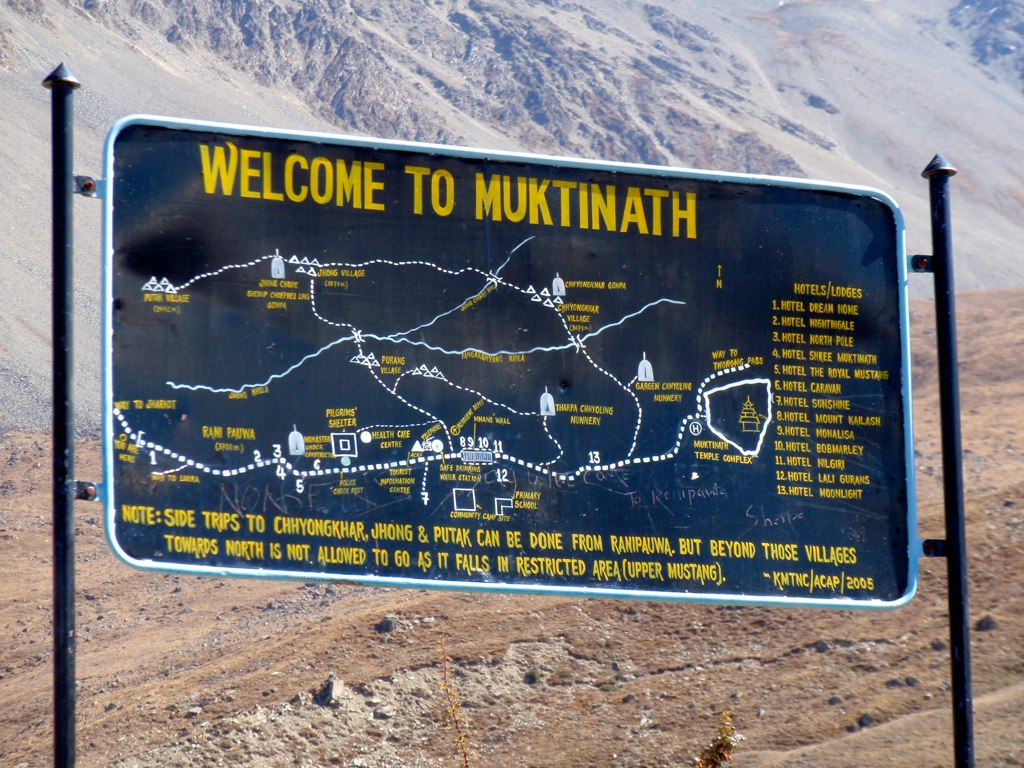
Understanding how to reach Muktinath Nepal is crucial for timing your visit during optimal accessibility windows. The temple’s remote location and extreme altitude create multiple transportation challenges that vary dramatically by season, weather conditions, and infrastructure maintenance. Multiple route options exist, but each requires careful timing coordination with weather patterns and local transportation schedules to ensure safe and successful arrival.
Air Route via Jomsom (Most Popular)
The aerial approach offers the quickest access but depends heavily on weather conditions for successful completion.
Route Details:
- Kathmandu to Pokhara: 25-minute flight or 6-hour drive
- Pokhara to Jomsom: 20-minute scenic mountain flight
- Jomsom to Muktinath: 2-hour jeep ride or 4-hour trek
- Total time: 4-6 hours (weather permitting)
- Cost: $200-300 per person including ground transport
Flight Schedule Considerations:
- Morning departures: 6:30 AM – 9:00 AM (weather dependent)
- Return flights: 9:30 AM – 11:30 AM (same day possible)
- Seasonal availability: March-November (weather permitting)
- Cancellation rates: 30-50% during marginal weather
Weather Impact:
- High winds: Common cause of flight cancellations
- Cloud cover: Prevents takeoff and landing
- Seasonal closure: December-February regular suspensions
- Backup planning: Essential due to weather unpredictability
Overland Route via Beni-Jomsom Road
The road journey offers more reliable scheduling but requires significantly more time and physical endurance.
Route Options:
- Kathmandu to Pokhara: 6-8 hours by tourist bus
- Pokhara to Jomsom: 8-10 hours by 4WD jeep
- Jomsom to Muktinath: 2 hours by local jeep
- Total journey time: 16-20 hours over 2-3 days
Road Conditions by Season:
- Spring (Mar-May): Good to excellent conditions
- Autumn (Sep-Nov): Generally good after repairs
- Monsoon (Jun-Aug): Frequent blockages and delays
- Winter (Dec-Feb): Often impassable due to snow and ice
Muktinath Temple Temperature and Weather Guide
Muktinath temple temperature variations are extreme due to the high altitude, requiring careful preparation for safe and comfortable pilgrimage experiences. The temple’s location at 12,300 feet creates weather patterns that can shift rapidly, with temperature swings of 20-30°C within a single day being common. Understanding these patterns helps pilgrims pack appropriately, plan arrival timing, and prepare for the physical challenges of high-altitude worship in varying conditions.
Monthly Temperature Analysis
| Month | Daytime High | Nighttime Low | Weather Condition | Pilgrimage Suitability |
|---|---|---|---|---|
| January | -5°C to 5°C | -20°C to -10°C | Severe cold, snow | Not recommended |
| February | -2°C to 8°C | -18°C to -8°C | Cold, occasional snow | Experts only |
| March | 2°C to 15°C | -10°C to -2°C | Improving conditions | Possible with preparation |
| April | 8°C to 18°C | -5°C to 5°C | Optimal period | Highly recommended |
| May | 10°C to 22°C | 0°C to 8°C | Peak comfort | Ideal for all pilgrims |
| June | 12°C to 20°C | 5°C to 10°C | Monsoon beginning | Weather dependent |
| July | 12°C to 20°C | 8°C to 12°C | Monsoon peak | Challenging access |
| August | 12°C to 20°C | 8°C to 12°C | Monsoon continues | Limited access |
| September | 8°C to 18°C | 2°C to 8°C | Post-monsoon clarity | Good conditions |
| October | 5°C to 15°C | -2°C to 5°C | Excellent visibility | Recommended |
| November | 0°C to 12°C | -8°C to 2°C | Winter approaching | Last good window |
| December | -5°C to 5°C | -15°C to -5°C | Winter onset | Not recommended |
Altitude Effects and Health Considerations
The muktinath height in feet at 12,300 feet creates significant physiological challenges that affect pilgrimage timing and preparation:
Altitude Sickness Prevention:
- Gradual ascent: Spend 1-2 days in Pokhara for acclimatization
- Hydration: Increase water intake significantly at altitude
- Medication: Consider altitude sickness prevention drugs
- Recognition: Know symptoms of altitude sickness for early intervention
Physical Preparation:
- Fitness level: Moderate fitness required for comfortable experience
- Age considerations: Elderly pilgrims need extra medical precaution
- Pre-existing conditions: Heart and lung conditions require medical clearance
- Insurance: High-altitude travel insurance strongly recommended
Muktinath Temple Tour and Yatra Planning
Comprehensive muktinath temple tour planning ensures spiritual fulfillment while managing the unique challenges of high-altitude pilgrimage. The remote location and extreme conditions require more detailed preparation than typical temple visits, including backup plans for weather delays, altitude acclimatization schedules, and emergency procedures. Proper muktinath yatra organization can transform a potentially difficult journey into a meaningful spiritual experience that honors the temple’s sacred significance.
Recommended Itinerary Options
Different itinerary lengths cater to varying time availability, fitness levels, and budget considerations for successful Muktinath pilgrimage experiences.
Standard 4-Day Yatra:
- Day 1: Kathmandu to Pokhara (acclimatization)
- Day 2: Pokhara to Jomsom to Muktinath (main pilgrimage)
- Day 3: Temple visits and local exploration
- Day 4: Return journey to Kathmandu
Extended 6-Day Experience:
- Days 1-2: Kathmandu to Pokhara with sightseeing
- Day 3: Travel to Jomsom and Muktinath
- Days 4-5: Temple ceremonies and regional exploration
- Day 6: Return with buffer day for weather delays
Luxury Helicopter Tour (1-2 Days):
- Morning: Direct helicopter from Kathmandu
- Afternoon: Temple darshan and return flight
- Benefits: Weather independence, comfort, time efficiency
- Cost: $2000-3000 per person
Many pilgrims combine their Muktinath journey with other Himalayan spiritual destinations, similar to comprehensive Uttarakhand pilgrimage packages that offer multi-temple experiences in sacred mountain regions.
Essential Preparations
Thorough preparation becomes critical for high-altitude pilgrimage success, covering documentation, gear, and health requirements specific to extreme mountain conditions.
Documentation Requirements:
- Passport: Valid for Nepal entry (Indian citizens)
- Permits: TIMS card and ACAP permit for trekking routes
- Insurance: Comprehensive travel and high-altitude coverage
- Medical certificates: For elderly or health-condition pilgrims
Gear and Equipment:
- Warm clothing: Layers for extreme temperature variations
- Altitude gear: Pulse oximeter, basic medications
- Footwear: Sturdy boots with good ankle support
- Emergency supplies: First aid kit, emergency food, water purification
Muktinath Tour Package Considerations:
- Group tours: Cost-effective with shared transportation and guides
- Private arrangements: Flexible scheduling and personalized service
- Local expertise: Essential for weather forecasting and route decisions
- Emergency protocols: Established procedures for medical and weather emergencies
Tips for Optimal Muktinath Experience
Strategic planning ensures you experience the best time to visit Muktinath while maximizing spiritual benefits and minimizing risks associated with high-altitude pilgrimage. These proven strategies help pilgrims navigate the unique challenges of reaching and worshipping at one of the world’s highest temples. Smart preparation combines weather awareness, health management, and cultural sensitivity to create meaningful spiritual experiences in this extraordinary sacred environment.
Weather and Timing Strategies
Optimal arrival timing throughout the day maximizes comfort and safety during your high-altitude pilgrimage experience.
Daily Timing Considerations:
- Early morning arrival: Best for clear mountain views and comfortable temperatures
- Midday temple visits: Warmest period for extended darshan and photography
- Evening departures: Avoid late afternoon wind patterns
- Night stays: Only recommended during peak season with proper accommodation
Seasonal Booking Strategies:
- Peak season reservations: Book 2-3 months ahead for April-May periods
- Weather backup plans: Always include extra days for flight delays
- Flexible scheduling: Choose tour packages with weather-dependent modifications
- Local weather monitoring: Connect with local weather services for updates
For devotees planning similar high-altitude spiritual journeys, Vaishno Devi pilgrimage packages offer comparable mountain temple experiences with expert guidance for challenging terrain and weather conditions.
Health and Safety Preparation
Physical and medical preparation ensures safe completion of your high-altitude spiritual journey.
Pre-departure Health Checks:
- Medical consultation: Especially important for heart, lung, or blood pressure conditions
- Fitness preparation: Light cardio exercise 4-6 weeks before travel
- Vaccination updates: Ensure routine vaccinations are current
- Medication planning: Bring extra supplies due to remote location
Altitude Management:
- Gradual ascent: Avoid direct flights to high altitude when possible
- Hydration protocol: Drink 3-4 liters of water daily at altitude
- Alcohol avoidance: No alcohol consumption during high-altitude period
- Sleep elevation: Sleep at lower elevation when possible
Cultural and Spiritual Enhancement
Meaningful engagement with local culture and traditions adds depth beyond basic temple darshan.
Spiritual Preparation:
- Religious learning: Study temple history and significance before arrival
- Meditation practice: Develop altitude-appropriate breathing techniques
- Cultural respect: Understand both Hindu and Buddhist customs
- Offering preparation: Bring appropriate items for temple ceremonies
Local Interaction:
- Guide services: Engage knowledgeable local guides for cultural context
- Language basics: Learn basic Nepali and Tibetan greetings
- Photography etiquette: Respect religious photography restrictions
- Community engagement: Support local businesses and craftspeople
For travelers seeking comprehensive multi-destination spiritual experiences, India tour packages can be combined with Nepal temple visits to create extensive pilgrimage circuits covering diverse sacred sites across the Himalayas.
Emergency Preparedness
Comprehensive emergency planning becomes crucial due to Muktinath’s remote location and challenging conditions.
Communication Planning:
- Satellite communication: Consider satellite phone rental for remote areas
- Emergency contacts: Register with local authorities and embassy
- Insurance verification: Confirm high-altitude and helicopter evacuation coverage
- Local emergency numbers: Keep accessible list of rescue and medical contacts
Weather contingency planning includes flexible scheduling and backup transportation options for successful pilgrimage completion.
For pilgrims interested in South Indian temple experiences with more predictable access, Tirupati darshan packages provide well-organized temple visits with professional crowd management and timing optimization services.
Conclusion
The best time to visit Muktinath requires careful balance between weather conditions, accessibility, and personal physical capabilities for successful high-altitude pilgrimage. April through May represents the optimal window for most pilgrims, offering the best combination of manageable temperatures, reliable transportation, and comfortable temple experiences. Essential planning includes altitude acclimatization, weather-appropriate gear, and flexible scheduling to accommodate the unpredictable mountain conditions at 12,300 feet elevation. Understanding muktinath temple temperature patterns and seasonal accessibility helps ensure your spiritual journey becomes a transformative experience rather than a dangerous ordeal.
You can visit us at VDP Travels, Neighbourhood Complex, F- 5, near SBI Bank, Sector 4, Nerul, Navi Mumbai, Mumbai, Maharashtra 400706. For comprehensive Muktinath pilgrimage packages with expert high-altitude guidance, weather-appropriate planning, and emergency support systems, call +91 99675 18405, or visit https://vdp-travels.com.
Best Time to Visit Muktinath – FAQs
What is the best time to visit Muktinath temple?
April through May offers the best combination of accessible roads, comfortable temperatures (8-22°C), and reliable flight schedules to Jomsom airport.
What is the Muktinath height in feet?
Muktinath temple is located at 12,300 feet (3,750 meters) above sea level, requiring proper altitude acclimatization for safe visits.
How to reach Muktinath Nepal from India?
Fly from India to Kathmandu, then to Pokhara, followed by a 20-minute flight to Jomsom and 2-hour jeep ride to Muktinath temple.
What is the Muktinath temple temperature in winter?
Winter temperatures range from -20°C to 5°C with severe cold and snow, making visits extremely challenging and generally not recommended.
Which is the best Muktinath tour package option?
4-6 day packages including acclimatization time, flexible flight schedules, and weather backup plans work best for most pilgrims.
What is the Muktinath temple history and significance?
This 2,000-year-old temple is sacred to both Hindus and Buddhists, known as Mukti Kshetra (place of liberation) with 108 water spouts and eternal flames.
When do flights to Jomsom get cancelled most?
December through February see frequent cancellations due to severe weather, while monsoon season (June-August) has 30-50% cancellation rates.
What should I pack for Muktinath yatra?
Pack warm layered clothing, sturdy boots, altitude medications, water purification tablets, and emergency supplies for high-altitude conditions.
Is altitude sickness common at Muktinath temple?
Yes, altitude sickness affects many visitors at 12,300 feet elevation. Gradual acclimatization and proper hydration help prevent symptoms.
Can elderly people visit Muktinath temple?
Elderly pilgrims can visit with proper medical clearance, gradual acclimatization, and peak season timing (April-May) for best weather conditions.

